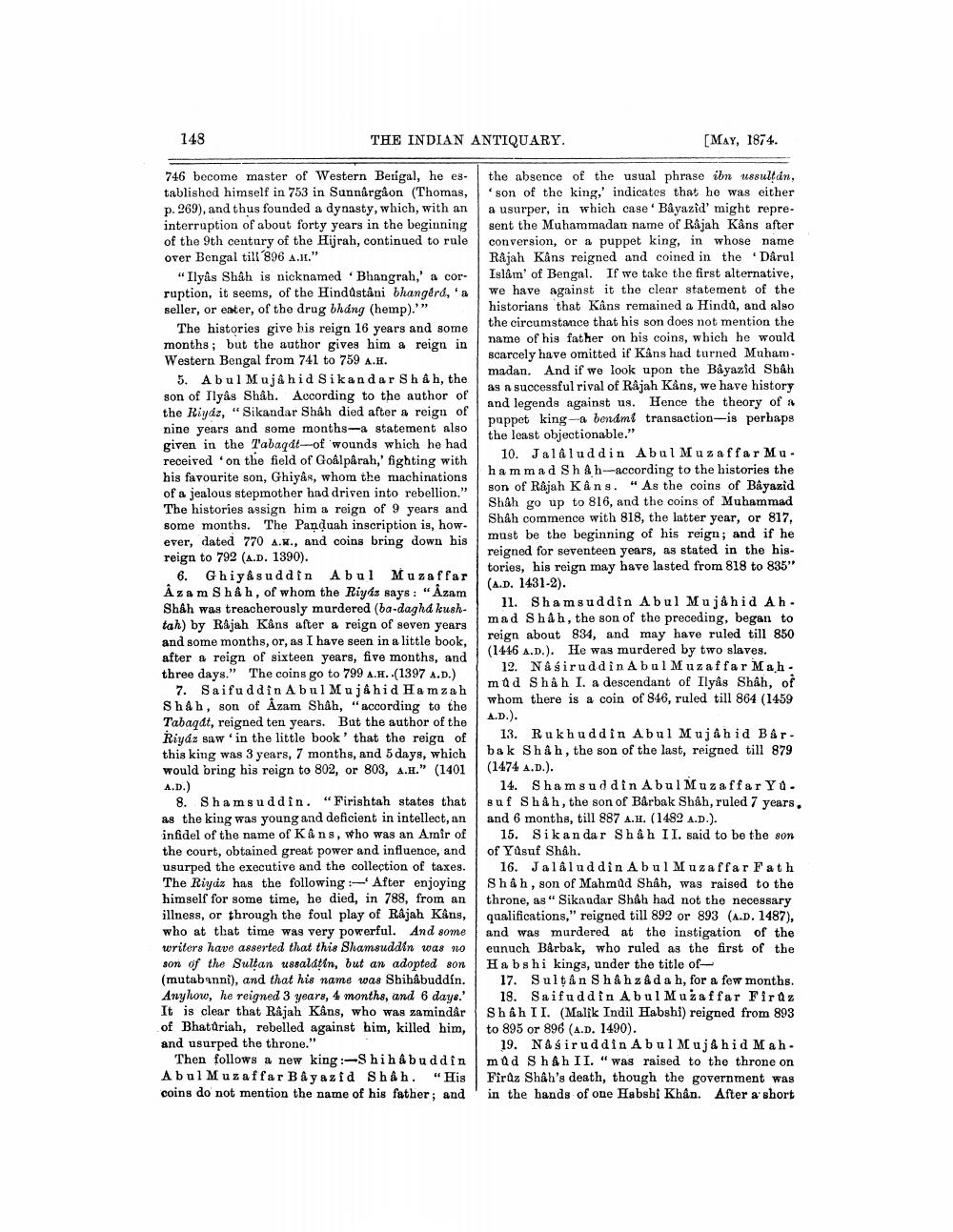________________
148
THE INDIAN ANTIQUARY.
746 become master of Western Berigal, he established himself in 753 in Sunnârgâon (Thomas, p. 269), and thus founded a dynasty, which, with an interruption of about forty years in the beginning of the 9th century of the Hijrah, continued to rule over Bengal till 896 A.H."
"Ilyas Shâh is nicknamed Bhangrah,' a corruption, it seems, of the Hindustâni bhangérd, a seller, or eater, of the drug bháng (hemp).""
The histories give his reign 16 years and some months; but the author gives him a reign in Western Bengal from 741 to 759 A.H.
5. Abul Mujahid Sikandar Shah, the son of Ilyas Shâh. According to the author of the Riyaz, "Sikandar Shâh died after a reign of nine years and some months-a statement also given in the Tabaqdt-of wounds which he had received on the field of Goâlpârah,' fighting with his favourite son, Ghiyâs, whom the machinations of a jealous stepmother had driven into rebellion." The histories assign him a reign of 9 years and some months. The Panduah inscription is, however, dated 770 A.K., and coins bring down his reign to 792 (A.D. 1390).
6. Ghiyasuddin Abul Muzaffar Azam Shah, of whom the Riyaz says: "Azam Shah was treacherously murdered (ba-dagha kushtah) by Rajah Kâns after a reign of seven years and some months, or, as I have seen in a little book, after a reign of sixteen years, five months, and three days." The coins go to 799 A.H..(1397 A.D.)
7. Saifuddin Abul Mujahid Hamzah Shah, son of Azam Shah, "according to the Tabaqát, reigned ten years. But the author of the Riyaz saw in the little book' that the reign of this king was 3 years, 7 months, and 5 days, which would bring his reign to 802, or 803, A.H." (1401 A.D.)
8. Shamsuddin. "Firishtah states that as the king was young and deficient in intellect, an infidel of the name of Kâns, who was an Amir of the court, obtained great power and influence, and usurped the executive and the collection of taxes. The Riyaz has the following: After enjoying himself for some time, he died, in 788, from an illness, or through the foul play of Rajah Kâns, who at that time was very powerful. And some writers have asserted that this Shamsuddin was no son of the Sultan ussaláṭin, but an adopted son (mutabanni), and that his name was Shihabuddín. Anyhow, he reigned 3 years, 4 months, and 6 days.' It is clear that Rajah Kâns, who was zamindar of Bhatûriah, rebelled against him, killed him, and usurped the throne."
Then follows a new king:-Shihabuddin Abul Muzaffar Bâyazid Shah. "His coins do not mention the name of his father; and
[MAY, 1874.
the absence of the usual phrase ibn ussultán, 'son of the king,' indicates that he was either a usurper, in which case' Bâyazid' might represent the Muhammadan name of Rajah Kâns after conversion, or a puppet king, in whose name Rajah Kâns reigned and coined in the Dârul Islâm' of Bengal. If we take the first alternative, we have against it the clear statement of the historians that Kâns remained a Hindu, and also the circumstance that his son does not mention the name of his father on his coins, which he would scarcely have omitted if Kâns had turned Muham. madan. And if we look upon the Bâyazid Shâh as a successful rival of Râjah Kâns, we have history and legends against us. Hence the theory of a puppet king-a bendmt transaction-is perhaps the least objectionable."
10. Jalaluddin Abul Muzaffar Mu. hammad Shah-according to the histories the son of Rajah Kâns. "As the coins of Bâyazid Shah go up to 816, and the coins of Muhammad Shah commence with 818, the latter year, or 817, must be the beginning of his reign; and if he reigned for seventeen years, as stated in the histories, his reign may have lasted from 818 to 835" (A.D. 1431-2).
11. Shamsuddin Abul Mujahid Ahmad Shah, the son of the preceding, began to reign about 834, and may have ruled till 850 (1446 A.D.). He was murdered by two slaves.
12. Nasiruddin Abul Muzaffar Mahmad Shah I. a descendant of Ilyas Shah, of whom there is a coin of 846, ruled till 864 (1459 A.D.).
13. Rukhuddin Abul Mujahid Barbak Shah, the son of the last, reigned till 879 (1474 A.D.).
14. Shamsuddin Abul Muzaffar Yusuf Shah, the son of Bârbak Shah, ruled 7 years. and 6 months, till 887 A.H. (1482 A.D.).
15. Sikandar Shah II. said to be the son of Yusuf Shah.
16.
Jalaluddin Abul Muzaffar Fath Shah, son of Mahmûd Shah, was raised to the throne, as" Sikandar Shâh had not the necessary qualifications," reigned till 892 or 893 (A.D. 1487), and was murdered at the instigation of the eunuch Bârbak, who ruled as the first of the Habshi kings, under the title of
17. Sultan Shahzada h, for a few months. 18. Saifuddin Abul Muzaffar Firuz Shah II. (Malik Indil Habshi) reigned from 893 to 895 or 896 (A.D. 1490).
19. Nasiruddin Abul Mujahid Mahmad Shah II. "was raised to the throne on Firûz Shâh's death, though the government was in the hands of one Habshi Khân. After a short




